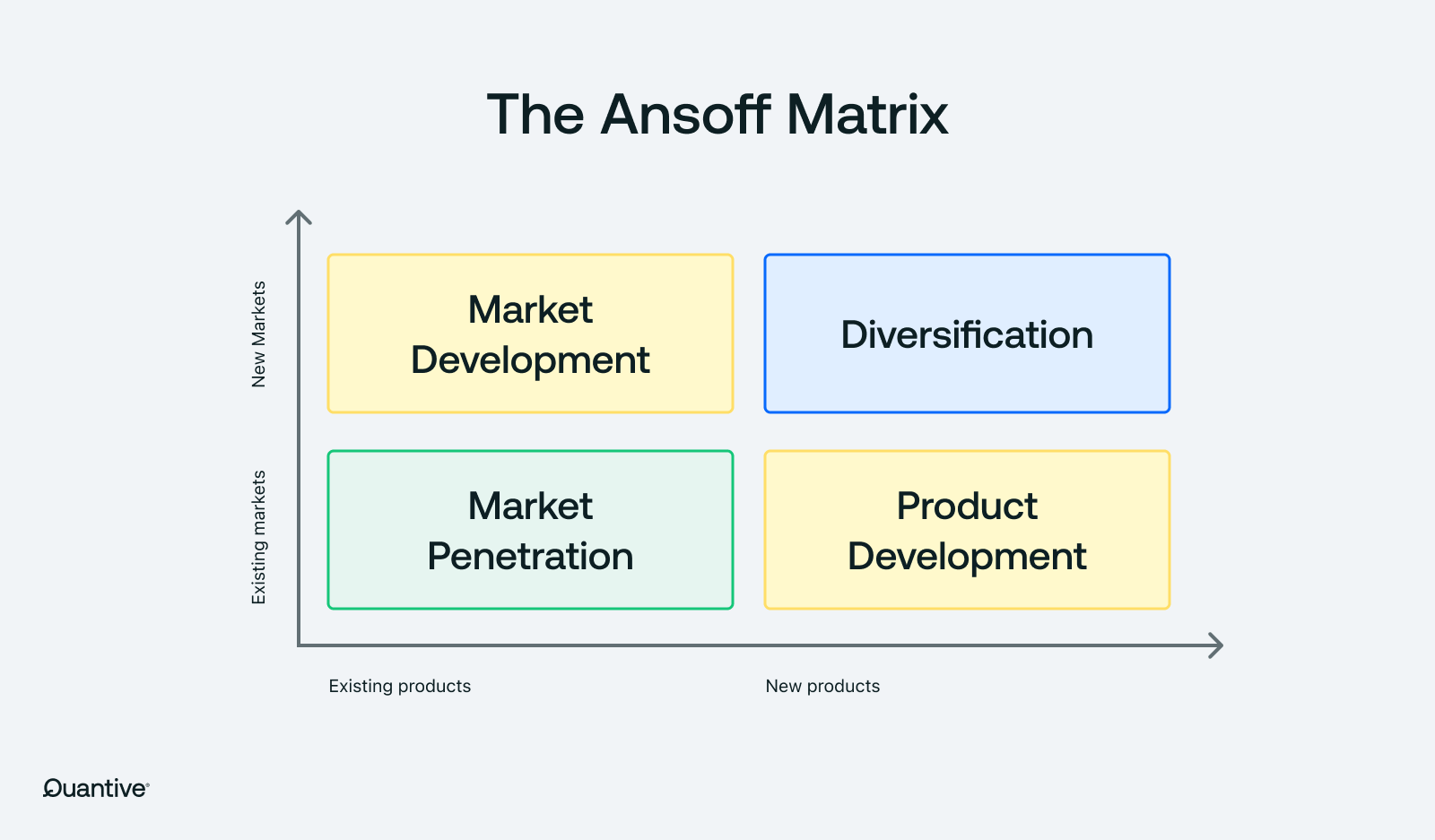Quantive is now part of WorkBoard. Get to know WorkBoard:
Planning the right business strategy can be difficult without a structured approach that accounts for all necessary business components. Strategic frameworks like the Ansoff Matrix can help you explore and evaluate various business growth strategies, concluding with the opportunity that provides the most suitable expansion plan.
This article will give you the ins and outs of the Ansoff Matrix, including its:
- Definition
- Elements
- Origins
- Use cases
- Example
- Steps
- Benefits
What is the Ansoff Matrix?
The Ansoff Matrix (sometimes called the Product/Market Expansion Grid) is a strategic framework and market development strategy that helps businesses identify growth opportunities by considering existing and new products or services in new or existing markets.
Core elements of the Ansoff Matrix
As a diversification strategy, the Ansoff Matrix outlines four strategies businesses can use to grow and helps them analyze the risk associated with each one.

The two axes of the Ansoff Matrix are ‘Products/Services’ and ‘Markets.’
- Products/Services: Existing or new offerings in your portfolio
- Markets: Existing or new customer segments you can target
The four growth strategies, each implying different levels of risk, exist within the Ansoff Matrix formed by these two axes.
Four growth strategies (H3)
- Market penetration: Selling existing products to existing markets (e.g., increasing marketing efforts and promotions to increase market share). This marketing strategy involves the least risk because it focuses on markets and products the existing business is already familiar with being sold to an existing market and existing customer base.
- Market development: Entering new markets with existing products (e.g., targeting new customer segments, geographical expansion). This strategy carries more risk than market penetration because it involves venturing into a new market segment with fresh marketing strategies to target new customers.
- Product development: Developing new products or services for existing markets (e.g., new product features, innovation). While familiarity with the market reduces some risks, developing new products or services can be costly and time-consuming. There's also the risk that the new products might not meet customer expectations or fail to gain market acceptance.
- Diversification: Offering new products or services to new markets (e.g., entering entirely new industries). This is the riskiest strategy because it introduces new products or services to new markets.
Who invented the Ansoff Matrix?
Igor Ansoff, a Russian-American mathematician and business manager, developed the Ansoff Matrix in his 1957 book Strategies for Diversification. His work laid the foundation for many modern strategic planning frameworks and tools, resulting in him being called "the father of strategic management."
When to use the Ansoff Matrix
You can use the Ansoff Matrix when you’re looking:
- You're looking for new ways to grow your business: If your business has reached a plateau or you’re seeking to expand, the Ansoff Matrix provides a structured approach to exploring different growth avenues.
- You want to explore opportunities in existing and new markets: Whether you aim to solidify your presence in current markets or expand into new ones, the Ansoff Matrix helps you evaluate the feasibility and risks associated with each option.
- You're considering launching new products or services: When innovation is at play, the Ansoff Matrix can help you introduce new products or services, enabling you to systematically analyze the potential impact of new offerings on existing or new markets.
- You need to improve resource allocation: If you’re working with limited resources and want to prioritize the most valuable work, the Ansoff Matrix can help you determine where to best focus your efforts by aligning your resources with the most promising growth opportunities.
Ansoff Matrix example: Facebook and VR case study
Let's consider Facebook (part of Meta), facing stagnant growth due to market saturation and increased competition. Meta is considering virtual reality (VR) as a strategic focus to re-engage users and tap into new opportunities.
Here’s how the Ansoff Matrix can help them explore VR's potential:
- Market Penetration: Use existing Facebook features to promote VR experiences (e.g., host live VR events on Facebook)
- Market Development: Target new user segments interested in VR social experiences (e.g., Target tech hubs and innovation centers with specialized VR social experiences)
- Product Development: Develop new VR features specifically for social interaction (e.g., Develop VR-based remote work solutions, such as virtual office environments where employees can collaborate and hold meetings)
- Diversification: Offer VR experiences beyond social networking (e.g., design VR games and immersive entertainment experiences)
How to use the Ansoff Matrix
Here’s a step-by-step guide to help you use the Ansoff Matrix:
Step 1: Identify your existing products and markets
To understand your current position and capabilities, the first step involves a comprehensive check of your current products and services, documenting key details such as features, customer segments, and market performance.
Step 2: Consider your resources and capabilities
To assess what you can achieve based on your internal strengths and capabilities, take a closer look at your existing resources and capabilities, including your tech stack, human capital, and operation strengths.
Step 3: Analyze market opportunities and threats
To identify external factors that could impact your growth strategies, conduct market research to identify opportunities and threats in existing and new markets. For more insights, look at industry trends, competitor activities, and changing customer needs.
Step 4: Evaluate each growth strategy based on your situation
To determine which growth strategy is most suitable for your situation and goals, assess the four growth strategies – market penetration, market development, product development, and diversification. Here are some examples of what each of these may entail:
- Market penetration: Pricing strategies, marketing campaigns, sales promotions
- Market development: Geographical expansion, targeting new customer segments, entering new distribution channels
- Product development: R&D, enhance product or service features, use customer feedback for new product ideas
- Diversification: Entering new industries, creating entirely new product lines
Step 5: Choose the strategies that best align with your overall business goals
To ensure your growth strategies support your long-term vision, mission, and goals, ensure alignment between these.
Benefits of using the Ansoff Matrix
As a strategic tool helping businesses tap into new opportunities, the Ansoff Matrix has many advantages for businesses wanting to grow and focus on market expansion. These include:
- Comprehensive growth analysis: Provides a detailed framework for evaluating company growth strategies, considering both existing and new products in existing and new markets to ensure a balanced approach to growth.
- Risk management: Categorizes growth strategies into four types, each with its level of risk, empowering businesses to make informed decisions by understanding the risk-reward trade-offs.
- Strategic focus: Helps prioritize growth initiatives by clearly distinguishing between viable opportunities and maximizing the potential for successful and efficient implementation of different growth strategies.
- Proactive adaptation to market change: Encourages continuous evaluation and refinement of strategies in response to market dynamics, allowing organizations to seize new opportunities in the current market scenario with related diversification and address emerging threats to stay agile.
Let Quantive StrategyAI be your strategic growth partner
Quantive StrategyAI can help you leverage the Ansoff Matrix or other goal management systems, such as the McKinsey7S model, to focus on new market development, tailoring it to your business to assess various opportunities. It can provide:
- Strategic context analysis to understand existing and new market opportunities
- Data-driven insights to determine the feasibility and potential risks of your chosen growth strategies
- Strategic planning to evaluate different growth trajectories and make informed decisions
Quantive StrategyAI is like having a strategic advisor at your side, guiding you through the Ansoff Matrix process and helping you chart a clear course for sustainable growth.
Quantive empowers modern organizations to turn their ambitions into reality through strategic agility. It's where strategy, teams, and data come together to drive effective decision-making, streamline execution, and maximize performance.
As your company navigates today’s competitive landscape, you need an Always-On Strategy to continuously bridge the gap between current and desired business outcomes. Quantive brings together the technology, expertise, and passion to transform your strategy and playbooks from a static formulation to a feedback-driven engine for growth.
Whether you’re a fast-growing scale-up, a mid-market business looking to conquer, or a large enterprise looking for innovation, Quantive keeps you ahead – every step of the way. For more information, visit www.quantive.com.





